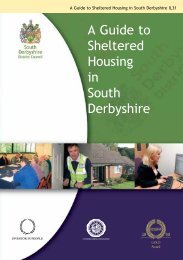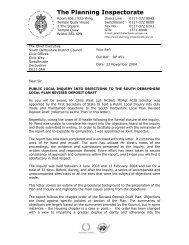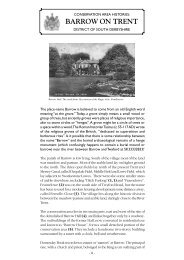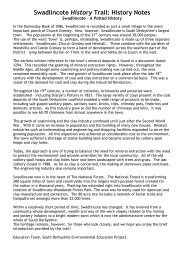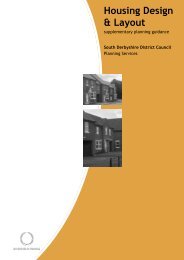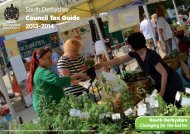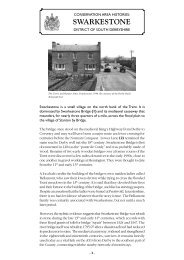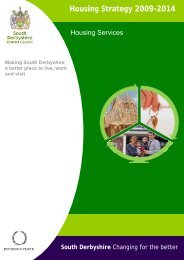Heritage News Issue 32 (8505KB) - South Derbyshire District Council
Heritage News Issue 32 (8505KB) - South Derbyshire District Council
Heritage News Issue 32 (8505KB) - South Derbyshire District Council
Create successful ePaper yourself
Turn your PDF publications into a flip-book with our unique Google optimized e-Paper software.
SOUTH DERBYSHIRE<br />
HERITAGE NEWS<br />
A newsletter of <strong>South</strong> <strong>Derbyshire</strong> <strong>District</strong> <strong>Council</strong>, Sharpe’s Pottery & Swadlincote T.I.C.<br />
<strong>Issue</strong> <strong>32</strong> Autumn 2010<br />
IT’S A DEAL!<br />
On 29th September, 1824, an important<br />
land exchange deal was signed<br />
between Sir George Crewe of Calke<br />
Abbey and Sir Francis Burdett of<br />
Foremarke Hall, involving land mostly<br />
at Milton/Repton and Ticknall. The<br />
exchange deed itself, with maps of the<br />
property concerned, was not known<br />
to survive until a counterpart of it<br />
turned up earlier this year.<br />
Calke Abbey and Foremarke Hall<br />
are both open to visitors over this<br />
year’s <strong>Heritage</strong> Open Days weekend,<br />
see pages 6 - 8 for details.<br />
Through long chains of land transactions,<br />
often over the course of several<br />
centuries, it might happen that two or<br />
more dominant families had substantial<br />
lands within a single parish, often intermixed.<br />
For instance, the manorial estate<br />
might belong to one landlord while the<br />
former church estates, confiscated at the<br />
Reformation, might belong to one or<br />
more other owners. So while the small<br />
parishes of Calke and Swarkestone<br />
belonged almost exclusively to the<br />
Harpurs of Calke in the 17th, 18th and<br />
19th centuries, the parishes of Church<br />
Gresley and Melbourne were in the<br />
divided ownership of greater and lesser<br />
owners.<br />
It is easy to understand why Sir<br />
George and Sir Robert wished to make<br />
an exchange, because it was mutually<br />
beneficial. Sir George owned a great<br />
deal of property in Milton, close to the<br />
heartland of Sir Robert’s estate at<br />
Foremark. Sir Robert, on the other hand,<br />
owned the former Repton Priory lands<br />
at <strong>South</strong>wood and Daniel Hayes Farm,<br />
Foremarke Hall which will be open for <strong>Heritage</strong> Open Days. See Page 6 for details.<br />
close to the south edge of Calke Park.<br />
(N.B. Tours of Daniel Hayes Farm are<br />
also on offer for <strong>Heritage</strong> Open Days,<br />
see p.6 ). In 1825 Sir George planted a<br />
band of trees along the ridge of Pistern<br />
Hills, on his newly acquired estate at<br />
<strong>South</strong>wood, to enhance the long views<br />
from Calke Park.<br />
It has always been known that the<br />
exchange took place, and details of the<br />
land transferred from Burdett to Crewe<br />
have always been fairly clear. Details of<br />
the land transferred from Crewe to<br />
Burdett in Milton and Repton were less<br />
clear, but earlier this year a counterpart<br />
of the exchange deed found its way into<br />
the hands of a private dealer, who has<br />
sold it to the <strong>Derbyshire</strong> Record Office<br />
(their reference D7309/1-3). As well as<br />
the written deed, covering fifteen large<br />
sheets of parchment, there are two beautifully<br />
drawn maps, coloured, with<br />
schedules briefly describing the property<br />
concerned, its acreages and tenants’<br />
<strong>Heritage</strong> <strong>News</strong> - 1<br />
names. The maps are not signed, but<br />
were probably drawn by Richard<br />
Crabtree, Sir Francis Burdett’s agent at<br />
Foremark.<br />
The transaction was on a grand scale;<br />
to give an idea of its magnitude, it may<br />
be remarked that the estates conveyed<br />
by one party to the other were both considerably<br />
larger than the entire parish of<br />
Calke. The land transferred from<br />
Burdett to Crewe amounted to 915<br />
acres, and the land transferred from<br />
Crewe to Burdett amounted to 897<br />
acres. As well as the <strong>South</strong>wood estate,<br />
the land transferred to Sir George Crewe<br />
included the Burdett Lime Works at<br />
Ticknall, the Scaddows at Ticknall and<br />
Hays Farm near Repton. The land transferred<br />
to Sir Francis Burdett included<br />
West Wood and Ingerholme Wood (now<br />
regarded as parts of Robin Wood) in<br />
addition to the lands at Milton and<br />
Repton.<br />
Continued on p.2....
...Continued from p.1<br />
It appears that the exchange<br />
actually took effect in 1821,<br />
which is the date recorded in<br />
published sources and indirectly<br />
confirmed by Sir<br />
George Crewe of Calke in his<br />
extensive diary: Sir George<br />
notes, in May 1821, that John<br />
Somers, the miller of Milton,<br />
was formerly his tenant but<br />
had lately become tenant to<br />
Sir Francis Burdett.<br />
In a drunken brawl at<br />
Derby with another of Sir<br />
George’s tenants, Somers<br />
was glassed in the face and<br />
died the same night while<br />
being escorted back from the<br />
privy, which was the real reason<br />
for Sir George’s diary<br />
If you are looking for a good day out<br />
this September, you need look no further<br />
than the Melbourne Festival of<br />
Creative and Performing Arts. It has<br />
been run by a small group of enthusiastic<br />
volunteers since 2005 and has<br />
established itself as a highlight of the<br />
County’s cultural calendar.<br />
This year’s Art and Architecture Trail<br />
on Saturday and Sunday 18th and 19th<br />
entry. The reason for the<br />
delay in finalising the<br />
exchange by a legal deed is<br />
not clear.<br />
The exchange deed is particularly<br />
valuable for providing<br />
a plan of most of Milton<br />
village, showing exactly the<br />
property in the village which<br />
had been Crewe’s, the property<br />
which was already<br />
Burdett’s (principally “The<br />
Farm”), and the property<br />
which remained in the hands<br />
of lesser freeholders, such as<br />
Brook Farm (Mr. Brown’s),<br />
Bramcote Lodge (Henry<br />
Wayte’s) and Kirby Holt (Mr.<br />
Somers’).<br />
In conjunction with the<br />
Milton Enclosure Award, for<br />
<strong>Heritage</strong> <strong>News</strong> - 2<br />
which there is no accompanying<br />
map, the exchange<br />
deed allows us to extrapolate<br />
backwards and reconstruct<br />
September will see approximately 100<br />
professional Artists and Makers exhibiting<br />
in over 50 private houses, public<br />
buildings and businesses in the historic<br />
heart of Melbourne. The work featured<br />
includes everything from abstracts to<br />
still life via botanical paintings, collage,<br />
landscapes, photography, print-making<br />
and much more.<br />
The 3-D artists are also out in force<br />
with jewellers, potters and sculptors<br />
amongst the many talents on show. All<br />
the work is for sale, commission free<br />
direct from the artists, so you can bag a<br />
bargain over the weekend. Michael<br />
Cook and Kate O’Melea are back;<br />
Michael’s stunning paintings inspired by<br />
the scriptures will be accompanied by a<br />
narrative by Kate in the awe-inspiring<br />
surroundings of the Parish Church. As<br />
part of the Arts <strong>Council</strong> supported<br />
Re:place project there will be installations<br />
by Kate Genever and Flora<br />
Gardner.<br />
In addition to the professional artists<br />
exhibiting on the Trail there will be<br />
exhibitions by local schools, art groups,<br />
buskers and musicians. Other activities<br />
along the trail include the 1623 Theatre<br />
Company with their Great<br />
Shakespearean Workout 2010 – aerobics<br />
the land holding pattern in<br />
Milton as it existed prior to<br />
Enclosure in 1757.<br />
ART, ARCHITECTURE AND MUCH MORE:<br />
A bird’s eye view of the art exhibition in<br />
Melbourne Leisure Centre at the 2009<br />
Festival.<br />
A detail of Milton village from the 1824 land exchange document,<br />
showing the lands transferred from Crewe to Burdett, with names of<br />
adjoining owners.<br />
MELBOURNE FESTIVAL 2010<br />
to Shakespeare, a chance to raise a sweat<br />
and a laugh. This really is a great day out<br />
in beautiful surroundings. It is also a<br />
rare opportunity to visit scores of buildings,<br />
many of them of historic interest,<br />
not usually seen by the public.<br />
This year’s programme of concerts<br />
and performances starts on 11th<br />
September and continues over the Trail<br />
weekend until 25th September.<br />
Melbourne now attracts acts from all<br />
around the country and the performance<br />
programme includes a broad spectrum<br />
of music including blues performer Dani<br />
Wilde, whose album “Shine” comes out<br />
in August and is predicted to make her a<br />
huge name. Other acts include Andra<br />
Sparks – jazz with a twist, Hothouse Big<br />
Band, Idle Hands and at the other end of<br />
the scale you can see Musica Donum<br />
Dei, the Sitwell Singers or join in with<br />
the Come and Sing choral workshop.<br />
If you prefer the spoken word you’ll<br />
enjoy the Library Theatre Company<br />
with “My Brilliant Divorce”, Comedy<br />
Night or “The Perfect Crime”.<br />
Don’t miss this great event - Full<br />
details are posted on the Melbourne<br />
Festival website – www.melbournefestival.co.uk<br />
or call 07765 819428.
RECENT EXCAVATION AT SHARPE’S<br />
Early bottle kilns actually<br />
consisted of two independent<br />
structures. One was the kiln<br />
itself, of cylindrical form,<br />
built of firebricks and bound<br />
together with stout iron<br />
bands. The other was the<br />
outer, enclosing structure<br />
known as a “hovel”, which<br />
served as a coal store, general<br />
shelter and chimney. This<br />
outer structure, more conical<br />
in shape, was the outward<br />
manifestation of a kiln, with<br />
which the outside world was<br />
familiar.<br />
At Sharpe’s today, the surviving<br />
“kiln” is actually this<br />
outer structure; the true kiln<br />
inside it may have been<br />
removed as early as the<br />
1860s, but its foundations<br />
were excavated by<br />
Northamptonshire<br />
Archaeology and <strong>Derbyshire</strong><br />
Archaeological Society some<br />
years ago, shortly before the<br />
restoration of the buildings in<br />
2002-2003.<br />
Excavation revealed that<br />
the kiln had been placed<br />
oddly off-centre within the<br />
enclosing structure, which<br />
In preparation for the proposed extension at the<br />
south end of the Sharpe’s Pottery buildings, an<br />
excavation was undertaken of the bottle kiln that<br />
was known to have existed there. The kiln was<br />
the twin of the one that still survives, and is<br />
thought to have been demolished in 1898.<br />
Together, they were the two kilns of the original<br />
pottery, founded in 1821.<br />
seems both impractical and<br />
needless, and has baffled<br />
industrial archaeologists. Did<br />
it mean that the kiln remains<br />
and the outer hovel belonged<br />
to different phases of building<br />
and did not co-exist?<br />
The kiln revealed itself<br />
only as a foundation trench as<br />
the firebricks had been comprehensively<br />
robbed out for<br />
re-use. The fireholes showed<br />
as coal-black patches, edged<br />
with the bright red of burnt<br />
bricks. There were indeed<br />
small traces of another kiln<br />
floor on top of the lower one,<br />
and the evidence suggested<br />
that this later floor was concentrically<br />
placed in the<br />
hovel.<br />
Several questions were<br />
<strong>Heritage</strong> <strong>News</strong> - 3<br />
posed previous to the excavation<br />
of the other kiln this<br />
summer. Would the kiln be<br />
found to be off-centre again?<br />
Would the remains be overlain<br />
with shards of pottery as<br />
was the case with the other<br />
kiln? Would there be better<br />
evidence of the kiln itself this<br />
time, or had the firebricks<br />
again been comprehensively<br />
robbed-out?<br />
Archaeologist Jon<br />
Goodwin reports on the findings,<br />
and gives his answers to<br />
the questions:<br />
“The remains of a pottery<br />
kiln, comprising a firing<br />
chamber and surrounding<br />
hovel, were uncovered within<br />
the excavation area, but these<br />
had been disturbed and truncated<br />
by several drains. What<br />
Volunteers cleaning the exposed kiln base at Sharpe’s, photographed by Zoe Sutherland of Stoke on Trent<br />
Archaeology.<br />
remained of the kiln’s firing<br />
chamber, however, was in a<br />
reasonable state of preservation,<br />
although only two to<br />
three courses of its brick<br />
foundations remained in situ.<br />
“The footings of the hovel<br />
survived on the eastern and<br />
western sides, but the northern<br />
and southern parts lay<br />
outside the limits of the excavation.<br />
It is likely that the<br />
hovel had an internal diameter<br />
of 8.60m, giving the original<br />
interior a circumference<br />
of 27.0m, marginally smaller<br />
than the extant kiln which is<br />
purported to be its contemporary.<br />
“The firing chamber was<br />
approximately 6.50m in<br />
diameter and was constructed<br />
of reddish common bricks<br />
jointed with white-grey fireclay<br />
mortar. It would originally<br />
have featured an estimated<br />
eight firemouths [as in<br />
the other kiln excavated<br />
before the conversion works,<br />
editor], beneath each of<br />
which would have been a rectangular<br />
ashpit.<br />
Partial remains of three of<br />
these ashpits survived within<br />
the base of the firing chamber.<br />
From what remained, it<br />
is estimated that the ashpits<br />
were c.1.30m in length and<br />
0.75m wide and survived to a<br />
depth of 0.14m. They were<br />
lined with grey-yellow firebricks<br />
bearing slight evidence<br />
of vitrification, with a<br />
gently sloping base at the distal<br />
end to presumably assist<br />
in raking out ash, clinker etc.<br />
“The foundation (‘cork’)<br />
for the firing chamber was<br />
revealed in a central 3.40m<br />
diameter well-hole within the<br />
structure. This cork comprised<br />
some pre-fired broken<br />
bricks, kiln furniture and<br />
Continued overleaf....
Bee boles create a buzz<br />
The whole complex of buildings at<br />
<strong>South</strong>wood House Farm, Ticknall, is<br />
currently under consideration for possible<br />
listing, but the only element formally<br />
listed so far by English <strong>Heritage</strong> is the<br />
garden walls, including a set of eleven<br />
“bee boles”, listed Grade II on 28th<br />
June, 2010. Positive decisions on the<br />
other buildings are expected shortly.<br />
Bee boles are cupboard-like recesses<br />
in walls. In Scotland, the word “bole”<br />
can refer to a small hatch, such as the<br />
ticket window at a railway station, a pay<br />
window at a factory, or the small opening<br />
of a hen house. It might also mean a<br />
recess in a wall used as a cupboard. In<br />
all these cases, the parallels with an<br />
English bee bole are clear. To complete<br />
the resemblance to a cupboard, bee boles<br />
might indeed have doors placed across<br />
the fronts in winter, to preserve the bees<br />
inside.<br />
Within the bee bole would be placed a<br />
“skep” for the bees to occupy, being like<br />
a conical straw basket turned upside<br />
down, with a single entrance at the bottom.<br />
The interior of the skep was completely<br />
hollow, leaving the bees to attach<br />
their own honeycomb structure to the<br />
internal surface. This was “technology”<br />
of the most primitive kind, with significant<br />
drawbacks: the interior of the skep<br />
could not be inspected for diseases and<br />
pests, and honey removal often resulted<br />
in the destruction of the entire colony.<br />
Beekeepers either drove the bees out of<br />
the skep, or killed them. The skeps were<br />
then squeezed in a vice to extract the<br />
honey.<br />
It’s not surprising that the inventive<br />
minds of the scientific revolution in the<br />
18th and 19th centuries turned their<br />
attention to the inefficiencies of beekeeping.<br />
By the second half of the 18th<br />
century, the design of skeps had been<br />
elaborated so that bees no longer had to<br />
be driven away or killed to harvest the<br />
honey. Developments culminated in the<br />
patenting of the Langstroth hive in the<br />
mid 19th century, which has become the<br />
standard model for three quarters of the<br />
world’s beekeepers.<br />
Bee keeping was a very common<br />
activity before sugar became plentiful<br />
and affordable as a sweetener. Bee boles<br />
were often built in sight of the dwelling<br />
house so that swarms could be detected<br />
and captured quickly; in addition such<br />
locations helped to familiarise the bees<br />
with human activity. As at <strong>South</strong>wood<br />
House, a southerly aspect was preferred,<br />
as it helped to keep the bees both dry and<br />
warm, and maximised their daylight<br />
hours and productivity. The garden within<br />
the walls probably included flowers<br />
to aid the production of honey and wax,<br />
and fruit trees, whose pollination would<br />
be assisted by the bees.<br />
The newly-listed bee boles at <strong>South</strong>wood House Farm.<br />
.... Continued from p3<br />
‘grog’ (ground up saggars)<br />
within a compact orange-red<br />
mixture of sandy clay and<br />
ash. Within the cork were at<br />
least two square-headed brick<br />
features that may have represented<br />
the remains of ashpits<br />
from an earlier firing chamber.<br />
Material found around<br />
these features included items<br />
of kiln furniture thought to be<br />
no later in date than the mid<br />
19th century.”<br />
Again, the kiln was found<br />
to be off-centre within the<br />
enclosing hovel, and one of<br />
the ashpits was placed<br />
improbably close to the hovel<br />
wall, leaving a gap of only a<br />
foot or so between the two.<br />
There was no conclusive evidence<br />
to show that the kiln<br />
and hovel remains were not<br />
in use at the same time, but<br />
equally it may be the case<br />
that the two kilns and hovels<br />
were both rebuilt in the mid<br />
19th century after a generation<br />
of intensive use.<br />
In both cases it is possible<br />
that the remains of higher,<br />
subsequent kiln floors have<br />
been totally removed in the<br />
<strong>Heritage</strong> <strong>News</strong> - 4<br />
past, leaving only the lower,<br />
original remains to be discovered<br />
in the excavations. As<br />
previously noted, there were<br />
slight remains of a later kiln<br />
floor structure over the kiln<br />
remains in the existing hovel.<br />
Few shard or artefacts were<br />
found, but several of the<br />
bricks were stamped “J.W.<br />
Bourne Church Gresley”.<br />
J.W.Bourne operated the pottery<br />
that later became<br />
Green’s “Top Bank” between<br />
1825 and 1834, so the bricks<br />
are a valuable dating clue.<br />
The bricks may, of course,<br />
The series of 11 bee boles at<br />
<strong>South</strong>wood House is a rarity, because<br />
anything more than eight in a set is<br />
unusual. A bill for bricks for them, dateable<br />
to about 1820, gives an indication<br />
of their date. <strong>South</strong>wood House Farm<br />
was one of the properties transferred by<br />
Sir Francis Burdett to Sir George Crewe<br />
in 1821 (see front page).<br />
RECENT EXCAVATIONS AT SHARPE’S POTTERY<br />
have been made on another<br />
site in the parish, but would<br />
still postdate J. W. Bourne’s<br />
coming of age in 1825.<br />
The excavation team comprised<br />
Richard Cramp, Zoe<br />
Sutherland and Heather Cope<br />
of Stoke on Trent<br />
Archaeology, project managed<br />
by Jon Goodwin. A further<br />
“watching brief” will be<br />
carried out by Stoke on Trent<br />
Archaeology when the newbuild<br />
project foundations are<br />
dug, and then the results of<br />
the whole work will be fully<br />
written up.
DO YOU OWN THE UGLIEST OR<br />
MOST BEAUTIFUL PIECE OF<br />
SOUTH DERBYSHIRE POTTERY?<br />
THE SOUTH DERBYSHIRE POTTERIES PRODUCED ITEMS BOTH OF GREAT<br />
BEAUTY AND GREAT HIDEOUSNESS. WE WANT TO SHOW THESE EXTREMES IN<br />
AN EXHIBITION NEXT YEAR AND WE NEED YOUR HELP.<br />
AS BEAUTY IS IN THE EYE OF THE BEHOLDER WE ARE LOOKING FOR LOANS OR<br />
PHOTOGRAPHS TOGETHER WITH A SHORT PIECE OF WRITING DESCRIBING<br />
WHY YOU THINK YOUR ITEM FITS THE BILL.<br />
MEET OUR CURRENT FORERUNNER FOR THE UGLIEST PIECE - FRANK. FRANK<br />
SITS ON AN ASHTRAY NEXT TO A LIFE-SIZE CIGARETTE AND HAS BEADY GLASS<br />
EYES! ONE OF BRETBY ART POTTERY’S FINEST!<br />
PLEASE SEND YOUR PHOTOGRAPHS AND TEXT TO EMMA FYFFE AT SHARPE’S<br />
POTTERY MUSEUM, WEST STREET, SWADLINCOTE DE11 9DG OR EMAIL<br />
EMMA.FYFFE@SHARPESPOTTERYMUSEUM.ORG.UK<br />
ALTERNATIVELY, FOR MORE INFORMATION CALL 01283 222600<br />
<strong>Heritage</strong> <strong>News</strong> - 5
FREE TO EXPLORE<br />
<strong>Heritage</strong> Open Days, a nationwide event which takes place on the<br />
second weekend of each September, is now firmly established in<br />
the cultural calendar. Overseen by English <strong>Heritage</strong> since the<br />
demise of the Civic Trust, it is the public’s chance to see<br />
buidlings of architectural, historic or cultural importance that<br />
are not normally open. In addition, heritage attractions which<br />
normally charge an admission fee may take part in <strong>Heritage</strong><br />
Open Days by opening for free, and places which are normally<br />
open free of charge may take part by staging extra events for the<br />
occasion.<br />
This year’s <strong>Heritage</strong> Open Days are<br />
9th – 12th September, and <strong>South</strong><br />
<strong>Derbyshire</strong>’s ten contributions to the<br />
event are as follows (NB participating<br />
properties choose their own opening<br />
times and visiting arrangements within<br />
the four days; please check the specific<br />
arrangements for any property<br />
you are interested in visiting):<br />
AN EARLY POTTERY SITE AT<br />
TICKNALL<br />
“Ivy Leigh”, 22, Main Street,<br />
Ticknall, Derby, <strong>Derbyshire</strong>, DE73<br />
7JZ<br />
In March 2010, an early 16th century<br />
pottery kiln was discovered at “Ivy<br />
Leigh”, long known to have been the<br />
site of one of Ticknall’s famous 16th -<br />
18th century potteries. Guides will be on<br />
hand to explain the site, which remains<br />
exposed and includes pots found in situ<br />
as well as remains of the kiln itself.<br />
house, in a pleasant rural setting, has<br />
been the Preparatory School for Repton<br />
School since 1947. The small church of<br />
Foremark, an unusual and well-preserved<br />
example from 1662 (also Grade<br />
I) will also be open.<br />
Directions<br />
Foremarke Hall is on the south side of<br />
Derby, accessed from the minor road on<br />
the south side of the River Trent<br />
between Repton and Swarkestone.<br />
Ample parking in front of house.<br />
Opening Times<br />
Thursday: One tour at 1130, maximum<br />
of 20 people, led by Julian Hawtree,<br />
Head of History, Foremarke School.<br />
Duration 1 hour approximately.<br />
Saturday: Three tours at 1130, maximum<br />
of 12 people on each, led by<br />
pupils of the school. Duration half an<br />
hour approximately.<br />
N.B. Pre-booking is required.<br />
Bookings are to be made with <strong>South</strong><br />
<strong>Derbyshire</strong> <strong>District</strong> <strong>Council</strong> by telephoning<br />
01283 228706<br />
DANIEL HAYES FARM, SMISBY:<br />
A BUILDING AND LANDSCAPE<br />
RESTORATION PROJECT<br />
Daniel Hayes Farm, Pistern Hills,<br />
Hartshorne, Swadlincote,<br />
<strong>Derbyshire</strong>, DE11 7AX<br />
Daniel Hayes has been a compact and<br />
self-contained estate since mediaeval<br />
times. The name is thought to mean “the<br />
enclosed land by the spring in the valley”,<br />
which refers to the source of<br />
Repton Brook. The tour will look at the<br />
process and pitfalls of restoring the 18th<br />
century farmhouse, farm buildings and<br />
field patterns. Also of interest are the<br />
rebuilding of the farm’s numerous<br />
derelict and lost ponds and the restoration<br />
of its ancient woodlands, along with<br />
the planting of over half a million new<br />
trees as part of the National Forest initiative.<br />
Directions<br />
Daniel Hayes Farm is about 11 miles<br />
south of Derby, at Pistern Hills, on the<br />
west side of the road from Ticknall to<br />
Ashby de la Zouch. Ample parking is<br />
Directions<br />
<strong>South</strong> of Derby on the A514 at Ticknall,<br />
on the corner of Harpur Avenue. Limited<br />
parking on street.<br />
Opening Times<br />
Saturday: 1000-1600<br />
Sunday: 1000-1600<br />
AN INSIGHT INTO FOREMARKE<br />
HALL<br />
Foremark Hall, Foremark, Milton,<br />
Derby, <strong>Derbyshire</strong>, DE65 6EJ<br />
Tours of Grade I listed country house<br />
designed by David Hiorns of Warwick<br />
for Sir Robert Burdett and built 1759-<br />
1761. Hiorns never saw the house, as he<br />
died in 1758 before work began. The<br />
Remains of the Old Hall at Swarkestone.<br />
<strong>Heritage</strong> <strong>News</strong> - 6
HERITAGE OPEN DAYS<br />
Swarkestone is served by frequent buses<br />
which run between Derby and<br />
Melbourne.<br />
An undated view of Gresley Old Hall, possibly 1920s, from the collection of R. B. Hall,<br />
printers, Swadlincote by courtesy of The Magic Attic.<br />
available in the ground and yards by the<br />
house.<br />
Opening Times<br />
Thursday: Tours 1030 and 1400<br />
Pre-booking is required.<br />
Bookings are to be made with Andrew<br />
Moseley on 01283 217365. Please leave<br />
a message if necessary, giving your<br />
name, number of visitors and a contact<br />
telephone number. Tours will last about<br />
one and a half to two hours each.<br />
Maximum of 20 people each tour.<br />
The tours may be cancelled if there are<br />
less than five places taken per tour by<br />
August 30th. Participants will be notified<br />
should cancellation be necessary.<br />
HILTON: HISTORY AND<br />
COMMUNITY DISPLAY AT THE<br />
OLD TALBOT INN<br />
The Old Talbot P. H., 1, Main<br />
Street, Hilton, Derby, <strong>Derbyshire</strong>,<br />
DE65 5FF<br />
Local history display by the newlyformed<br />
Hilton and Marston Local<br />
History Group, staged in a cruck framed<br />
building that is one of the village’s most<br />
important historic buildings. Other community<br />
groups will also be in attendance.<br />
Refreshments available, as normally<br />
offered by the pub.<br />
Directions<br />
The Old Talbot stands by the main<br />
A51<strong>32</strong> road at Hilton, about eight miles<br />
south west of Derby. Car park at rear.<br />
Frequent V1 and V2 buses run between<br />
Derby and Burton and stop directly outside<br />
the pub.<br />
Opening Times<br />
Saturday: 1230-1600<br />
SWARKESTONE OLD HALL:<br />
RELICS OF A LOST COUNTRY<br />
HOUSE<br />
Old Hall Farm, Derby Road,<br />
Swarkestone, Derby, <strong>Derbyshire</strong>,<br />
DE73 7JB<br />
Swarkestone Hall, a grand Elizabethan<br />
home of the Harpur family, was pulled<br />
down in the 1740s. This self-guided trail<br />
explores and explains the impressive<br />
remaining features, which include a mid<br />
17th century stable block, a large stone<br />
outbuilding, a banqueting house, walled<br />
gardens and a fragment of the house<br />
itself.<br />
There will be no internal access to<br />
these buildings but the parish<br />
church will also be open on Saturday<br />
afternoon, with display material about<br />
the village in general.<br />
Directions<br />
Off the A514 by the River Trent at<br />
Swarkestone, south of Derby. Limited<br />
parking by parish church on Church<br />
Lane.<br />
Opening Times<br />
Friday: 1100-1700<br />
Saturday: 1100-1700<br />
Sunday: 1300-1700<br />
THE VARIED HISTORY OF<br />
GRESLEY OLD HALL<br />
Gresley Old Hall, Gresley Wood<br />
Road, Church Gresley, Swadlincote,<br />
<strong>Derbyshire</strong>, DE11 9QW<br />
A small country house built in various<br />
phases from the 1580s to c1710,formerly<br />
the seat of the Alleyne family. It was<br />
later a tenanted farmhouse before<br />
becoming a Miners’ Welfare Centre in<br />
the 1950s. For a short period around<br />
1800 it was home to an unsuccessful<br />
china factory.<br />
A self-guided trail will set out the chequered<br />
history of the house, ending with<br />
a chance to view the collection of the<br />
<strong>South</strong> <strong>Derbyshire</strong> Mining Preservation<br />
Group. Refreshments will be available<br />
at the Indoor Bowling Centre adjacent to<br />
the Old Hall.<br />
Directions<br />
Gresley Old Hall lies half way between<br />
Swadlincote and the A444 at Castle<br />
Gresley. The approach is from Gresley<br />
Wood Road, north of the house.<br />
Plentiful parking on car park by house.<br />
Opening Times<br />
Thursday: 1100-1700<br />
Friday: 1100-1700<br />
Saturday: 1100-1700<br />
TWYFORD: CHURCH, PARISH<br />
AND PEOPLE<br />
Ferry Lane, Twyford, Twyford,<br />
<strong>Derbyshire</strong>, DE73 7HJ<br />
Local history display including old pictures<br />
of the ferry, other old photographs,<br />
family trees, census records, school logbook,<br />
maps and plans, transcriptions of<br />
memorial inscriptions, church registers<br />
Continued on p8...<br />
<strong>Heritage</strong> <strong>News</strong> - 7
FREE TO EXPLORE<br />
Directions<br />
10ml S of Derby, on A514 at Ticknall<br />
between Swadlincote and Melbourne.<br />
Access from M42/A42 exit 13 and A50<br />
Derby <strong>South</strong>. Free parking 500 yards.<br />
By bus: Arriva 61 alight Ticknall, then 1<br />
mile walk through park to house.<br />
The Roman Catholic Church at Swadlincote..<br />
.... Continued from previous page<br />
etc. Refreshments available (tea, coffee,<br />
cold drinks and home-made cakes).<br />
Directions<br />
On the River Trent south of Derby, off<br />
the A51<strong>32</strong> between Willington and<br />
Swarkestone. Limited on-street parking<br />
Opening Times<br />
Saturday: 1000-1600<br />
ST PETER & ST PAUL’S<br />
CATHOLIC CHURCH<br />
70 Newhall Road, Swadlincote,<br />
<strong>Derbyshire</strong>, DE11 0BD<br />
The church dates from 1958, but the<br />
site includes a Victorian shrine. There<br />
will be an exhibition in the church on the<br />
shrine’s history, the history of the church<br />
and its place in the community. Quizzes<br />
for children. Tea, coffee, soft drinks,<br />
cakes, biscuits and various sandwiches.<br />
Directions<br />
The church is at the top of Darklands<br />
Road, between Swadlincote and<br />
Newhall, at grid ref. SK297203.<br />
National Cycle Route 63 crosses<br />
Darklands Road. Frequent buses pass<br />
the church. For public transport details,<br />
go to www.travelineeastmidlands.org.uk<br />
or call Traveline on 0870 608 2608.<br />
Opening Times<br />
Thursday 9th September: 0930-1600<br />
Friday 10th September: 0930-1600<br />
Saturday 11th September: 0930-1600<br />
CALKE ABBEY<br />
Ticknall, Derby DE73 7LE<br />
Calke Abbey, remodelled from an earlier<br />
house in 1701-4, will need no introduction<br />
to local readers. It is preserved<br />
as it was found in the 1980s, its faded<br />
glory allowing visitors to explore a period<br />
when great country houses struggled<br />
to survive.<br />
Today it is poised somewhere between<br />
gentle neglect and downright dereliction,<br />
telling the tale of an eccentric family<br />
who amassed a huge collection of<br />
hidden treasures. Eye spy sheet for children.<br />
Chellaston School pupil Annabel<br />
Blatch, of Melbourne, spent work<br />
experience week with the editor at<br />
<strong>South</strong> <strong>Derbyshire</strong> <strong>District</strong> <strong>Council</strong> in<br />
July. In this short article, Annabel<br />
gives a view on “why heritage is<br />
important today”:<br />
Historic buildings are an important<br />
part of our environment. However,<br />
many of them, such as factories and<br />
mills, have had to be saved from falling<br />
into disrepair by finding imaginative<br />
new uses for them. These are buildings<br />
Opening Times<br />
Saturday 11th September: 1230–1700<br />
(Last admission 1630).<br />
All visitors are asked to collect their free<br />
admission tickets from the Visitor<br />
Reception. Timed Ticket entry to the<br />
House will apply. Please arrive in good<br />
time as tickets will run out. The restaurant<br />
is open 1030-1700. The shop is<br />
open 1030-1700. Buggy service available.<br />
MELBOURNE HALL GARDENS<br />
Church Square, Melbourne<br />
DE73 8EN<br />
Remarkable historic garden laid out in<br />
1704, with statuary, picturesque pools, a<br />
yew tunnel and a unique wrought iron<br />
arbour known as ‘The Birdcage’, made<br />
in 1708. Unusual shrubs and trees with<br />
imaginative planted borders. The house<br />
itself will not be open.<br />
Directions<br />
Eight miles south of Derby. There are<br />
frequent bus services to Derby and<br />
Swadlincote.<br />
Opening Times<br />
Saturday 11th September: 1330-1730<br />
How the past continues<br />
that should be preserved, because they<br />
show future generations what life was<br />
like many years ago.<br />
All over the country many old buildings<br />
are currently derelict and uncared<br />
for, but organisations such as English<br />
<strong>Heritage</strong>, the National Trust and the<br />
Landmark Trust look after many of<br />
them, making sure that they are preserved<br />
and given the funding they need.<br />
Historic buildings show people what<br />
the local area used to be like, because<br />
<strong>Heritage</strong> <strong>News</strong> - 8
BUTTERPOTS AND FINGERPRINTS –<br />
SURPRISING FINDS AT TICKNALL<br />
Several exciting things<br />
have happened since the<br />
launch of the Ticknall<br />
Archaeological Research<br />
Group. In March, an excavation<br />
in the garden of<br />
Ivyleigh in the village<br />
turned up what was<br />
thought to be two kilns,<br />
with one partially overlaying<br />
the other.<br />
A second excavation in<br />
early August, to determine<br />
the precise nature and extent<br />
of the site, now suggests just<br />
one kiln, possibly a clamp<br />
kiln, sealed for some reason<br />
with a thick layer of clay and<br />
eventually covered with<br />
thousands of shards of 17th<br />
century Midland purple and<br />
yellow wares. The jury is<br />
still out on this one!<br />
Barbara Foster of the Ticknall Archaeological<br />
Research Group (TARG) writes<br />
The kiln itself has been<br />
provisionally dated to 1500<br />
and provided a good haul of<br />
large butter pots, many intact,<br />
some of which had been used<br />
as saggers to protect more<br />
delicate wares as they were<br />
being fired. A rather nice jug<br />
was found in one of them.<br />
Perhaps the most personal<br />
category of finds were the<br />
squeezers or spacers – rough<br />
handfuls of clay used to separate<br />
the pieces being fired –<br />
some in fact were quite tiny,<br />
about the size of a 10p and<br />
bearing the thumbprint of the<br />
potter. Finding these is quite<br />
a moving experience! As the<br />
discovery of such early kilns<br />
is quite a rare event, this and<br />
earlier Ticknall digs have<br />
excited much academic and<br />
specialist interest. They<br />
should ensure that the unique<br />
identity of Ticknall pottery<br />
achieves the recognition it<br />
deserves.<br />
In addition to the digging,<br />
the many volunteers were<br />
also involved in a serious<br />
amount of pot washing – well<br />
worth the effort as mud covered<br />
shapes became explicable<br />
and the glorious shiny<br />
colours could be fully appreciated.<br />
A short course on the<br />
basics of pottery identification<br />
was also given and a<br />
couple of days were spent<br />
learning the basic principles<br />
of field walking on a newly<br />
ploughed field on Staunton<br />
Lane. This turned up some<br />
more pots to wash, but an<br />
analysis of the spread and<br />
type of the finds is awaited<br />
<strong>Heritage</strong> <strong>News</strong> - 9<br />
before their significance can<br />
be assessed. A course on<br />
landscape surveying will take<br />
place shortly, we hope.<br />
Four geophysical surveys<br />
have been done in areas of<br />
possible pottery sites. There<br />
are many of them, because<br />
family pot making businesses<br />
were spread around the<br />
parish over hundreds of<br />
years. One site, showing as<br />
an interesting bump, has now<br />
been discounted because it<br />
turned out to be a medieval<br />
headland, i.e. a remnant of<br />
ridge and furrow plough<br />
lands where the headland was<br />
formed as the plough turned<br />
round at the end of the furlong.<br />
The other sites look<br />
more promising.<br />
The Group has also taken<br />
part in local and national<br />
events. There were displays<br />
at Calke Abbey for their<br />
Archaeology Week in June<br />
and the site was open to visitors<br />
at the end of July as part<br />
A 500 year-old butterpot emerges from the excavation at Ivy Leigh in<br />
March.<br />
to influence the present day<br />
building materials used in old houses<br />
were mostly produced in the local area.<br />
However, modern buildings can be<br />
made of any material from any part of<br />
the country, which means from looking<br />
at a modern house you wouldn’t be able<br />
to tell where certain materials have<br />
come from.<br />
An historic environment isn’t just<br />
about buildings, it also includes the<br />
landscape, the countryside and transport<br />
networks. Canals, railways and public<br />
footpaths were originally for necessary<br />
transport and travel, but are now used<br />
for leisure activities. Canal boats are<br />
now for pleasure, and railway lines have<br />
been turned into cycle tracks. Footpaths<br />
that were originally small lanes, or<br />
routes for people to get to work, are now<br />
used mostly for leisure walks. So heritage<br />
is not just for people who are interested<br />
in history. It is relevant to everyone.<br />
We all use heritage legacies, so we<br />
need to make sure that we look after<br />
them. The places around us show the<br />
of the <strong>Council</strong> of British<br />
Archaeology’s national<br />
Archaeology Festival. It will<br />
also be open for <strong>Heritage</strong><br />
Open Days, the details of<br />
which are on Pages 6 - 8 of<br />
this newsletter. We hope that<br />
you will come and have a<br />
look at this exciting and<br />
interesting piece of history.<br />
past of our country and continue to<br />
influence the present day.<br />
The “Picture of Health” fitness studio and<br />
gym in Melbourne is a good example of the<br />
creative re-use of a former shoe factory.
One of the pleasures of visiting<br />
historic buildings in connection<br />
with planning proposals is<br />
the discovery of well-preserved<br />
and unexpected interior features.<br />
For instance, Somerville<br />
House at Findern is a handsome<br />
but plain house, where one<br />
would not expect anything out<br />
of the ordinary. And yet its original<br />
kitchen boasts first-rate<br />
rubbed brick arches, one elliptical<br />
and one circular, and formerly<br />
pointed with bright white<br />
lime. It is workmanship that<br />
would be quite at home in a topranking<br />
townhouse.<br />
For the editor, one of the most endearing<br />
categories of find is the blue and<br />
white Delft or Dutch tiles, particularly<br />
popular in England during the first half<br />
of the 18th century. They are tin-glazed,<br />
which produced an opaque white or<br />
cream colour, with a design on top, often<br />
pictorial and often done in cobalt blue.<br />
The result was earthenware tiles with a<br />
convincing resemblance to the fine blue<br />
and white Chinese porcelain that<br />
inspired them. It has been estimated that<br />
800 million of these tiles were produced<br />
over a period of 200 years! They were<br />
widely exported, so their continued<br />
presence in <strong>South</strong> <strong>Derbyshire</strong> need not<br />
surprise us. Delftware tiles even reached<br />
- Curiosity Corner -<br />
Going Dutch<br />
China and Japan, the ultimate home of<br />
blue and white, where the natives<br />
responded by producing true porcelain<br />
versions of Delftware for export back to<br />
Europe. English “Delftware” was also<br />
produced.<br />
It seems that Delft tiles were popular<br />
in England as surrounds to the smaller<br />
firegrates found in bedrooms and dressing<br />
rooms where, in the editor’s limited<br />
experience, they are most likely to be<br />
found today. It may be, of course, that<br />
they were popular for ground floor<br />
rooms too, but have been superseded by<br />
the more frequent replacement of fireplaces<br />
there.<br />
The Calke Abbey accounts give some<br />
clues to prices and uses: in 1734,<br />
William Saywell was paid £1 2s 9d for 8<br />
dozen Dutch Tiles (purpose unspecified),<br />
and in 1738 12 shillings was paid<br />
for four dozen of blue Dutch tiles “for<br />
the Chimney in my Lady's Closet”. In<br />
1740, £1 12s was paid for 42 fine Dutch<br />
Tiles for Miss Harpur’s chimneypiece,<br />
and an additional 18s 6d was spent on 6<br />
feet more of Dutch tiles for the same<br />
purpose. From this it seems that the<br />
going rate for ordinary Dutch tiles was<br />
about three shillings per dozen, or 4d<br />
each, while the fine ones cost about 9d<br />
each.<br />
Surviving examples have recently<br />
been observed at Blenheim House in<br />
Etwall and at Muse Lane Farm in<br />
Church Broughton, both in first floor<br />
front bedrooms of the mid 18th century.<br />
It is probably no coincidence that these<br />
buildings appear to be close in date to<br />
the references in the Calke Abbey<br />
archives, pointing to their period of<br />
greatest popularity.<br />
Details of the Dutch tiles in <strong>South</strong><br />
<strong>Derbyshire</strong>. Three wise men follow the star at<br />
Blenheim House, Etwall (above) and peacocks<br />
and vine at Muse Lane Farm in Church<br />
Broughton (right).<br />
The Blenheim House tiles are “bible<br />
tiles”, each depicting a bible story. At<br />
Muse Lane Farm, the emphasis is on<br />
peacocks, birds, vines and flowers. The<br />
Dutch potters even produced sets of<br />
plates with the words and music of<br />
songs; dessert was served on them and<br />
when the plates were clear the diners<br />
started singing!<br />
<strong>Heritage</strong> <strong>News</strong> - 10
TITHE BARN AT MELBOURNE<br />
IS REPAIRED<br />
The so-called Tithe<br />
Barn at Melbourne had<br />
been in a state of gentle<br />
decay for many decades<br />
prior to its recent repair.<br />
Its mouldering stone<br />
walls had a weather-beaten,<br />
cliff-like charm of<br />
their own, but the condition<br />
of the building had<br />
declined to a state where<br />
remedial work was long<br />
overdue. There were<br />
holes in the roof, and sections<br />
of brick and<br />
stonework were threatening<br />
to fall out.<br />
The building has not been<br />
in full use since it ceased to<br />
be a malthouse in the 1880s;<br />
little appears to have been<br />
done to it since, other than<br />
replacement of the thatch<br />
with tiles on the higher part<br />
of the building, and some<br />
associated minor brickwork<br />
repairs apparently done at the<br />
same time. It was acquired by<br />
the Melbourne Hall Estate in<br />
1927 and is now the property<br />
of Lady Ralph Kerr of<br />
Melbourne Hall.<br />
Building contractor Alan<br />
Staley and his team have<br />
done a very neat and careful<br />
job of re-roofing the building,<br />
making use of irregular handmade<br />
clay tiles on the side<br />
facing the church.<br />
Much of Alan’s work has<br />
involved the conversion of<br />
the later and lower, southern<br />
part of the building to residential<br />
use, but this is largely<br />
out of public view.<br />
Repair of the walls of the<br />
mediaeval building has<br />
proved to be a very sensitive<br />
and somewhat contentious<br />
issue, particularly bearing in<br />
mind its proximity to the<br />
great west door of the parish<br />
church, which plays such an<br />
important role in so many<br />
weddings and funerals. How<br />
could the repairs be done<br />
without damaging the “soft”<br />
patina of the building and its<br />
aura of antiquity?<br />
Maintenance of the building<br />
had been abandoned for<br />
so long that drastic remedial<br />
work to the brick and<br />
stonework was inevitable.<br />
The building was originally<br />
constructed of neatly cut,<br />
tightly-jointed stone blocks.<br />
On the east side, where these<br />
had severely weathered back,<br />
the wall surface had been<br />
repaired long ago with rubblestone<br />
patching, but continued<br />
weathering was causing<br />
the rubble patching to loosen<br />
and fall out.<br />
Should the new repairs perpetuate<br />
and increase the rubble<br />
patching, which was only<br />
ever a cheap expedient, or<br />
should squared stone blocks<br />
be reinstated in line with the<br />
original character of the<br />
masonry?<br />
To use rubblestone again<br />
would have been softer on<br />
the eye, but would have been<br />
disrespectful and unfaithful<br />
to the architectural quality of<br />
the building and its Grade II*<br />
listed status. On the other<br />
hand the decision to use large<br />
squared stones for the repairs,<br />
as in the original building,<br />
caused some disquiet locally<br />
because it will inevitably<br />
appear harsh and angular for<br />
some time to come.<br />
It would have been both<br />
dishonest and difficult to<br />
<strong>Heritage</strong> <strong>News</strong> - 11<br />
A Victorian photograph of the Tithe Barn at Melbourne, recently<br />
repaired.<br />
round the corners to simulate<br />
centuries of weathering, as on<br />
the adjacent stonework.<br />
Moreover, recognised good<br />
practice with the fine<br />
stonework of cathedrals,<br />
churches and ancient monuments<br />
is to reinstate<br />
stonework in line with the<br />
face of its original plane,<br />
sharp corners and all.<br />
In dilemmas such as this,<br />
there is no possibility of<br />
pleasing everyone. The face<br />
of the new stonework has<br />
been lightly abraded to make<br />
its smooth-sawn surface<br />
more gritty, which is itself a<br />
very questionable practice,<br />
but was done here to<br />
acknowledge the texture of<br />
the overall building given the<br />
special circumstances and<br />
close-range views.<br />
In addition, stonemason<br />
Andy Oldfield has used<br />
artistry and a few tricks of the<br />
trade to blend the old<br />
stonework with the new as<br />
far as possible. He has used<br />
tinted soft lime mortar repairs<br />
to fill areas of weathered but<br />
salvageable stonework,<br />
building up the faces of the<br />
stone to provide smoother<br />
junctions with the new work.<br />
To further help the new<br />
stonework look more at<br />
home, it has been “weathered”<br />
with the help of bacteria-laden<br />
yoghurt and tea!<br />
The external work is complete<br />
but much remains to be<br />
done inside. However, now<br />
that the scaffolding is down<br />
and the building looks more<br />
settled, the emerging general<br />
consensus seems to be that<br />
the vulnerable, time-worn<br />
character of the building has<br />
not been so radically altered<br />
by the repair works as was<br />
feared.<br />
Moreover, the building can<br />
now be removed from the<br />
county list of historic buildings<br />
“at risk” from decay and<br />
dereliction.
DANIEL HAYES FARM<br />
Until 1880, Daniel Hayes After the Dissolution,<br />
Of all the venues on offer for <strong>Heritage</strong> Open Days this<br />
was a detached part of the Daniel Hay was bought by<br />
year, Daniel Hayes Farm is probably the least known. The<br />
parish of Repton, reflecting Thomas Thacker, who also<br />
editor explains why the site is of interest, both because of<br />
the fact that it had been given bought the old priory at<br />
its past and because of what is happening there now.<br />
to Repton Priory by the Repton. It appears to have<br />
<strong>Heritage</strong> Open Days 2010<br />
provides a rare opportunity to<br />
learn a little about the history<br />
Conservation Group which<br />
existed throughout the project.<br />
Hartshorne family, and it<br />
remained the property of the<br />
priory until its dissolution in<br />
been at this point, in the mid<br />
16th century, that a house<br />
was first built on the estate.<br />
and ongoing restoration of<br />
1539. Daniel Hayes sounds Mary Thacker left her<br />
Daniel Hayes Farm, a compact<br />
historic estate near<br />
Smisby.<br />
The site was purchased by<br />
the present owners in 2001<br />
and since then has been the<br />
subject of a major landscape<br />
and building restoration plan.<br />
Understanding of the site was<br />
The tours, led by Andrew<br />
Moseley, will look at the<br />
process and pitfalls of restoring<br />
the farmhouse and farm<br />
buildings, going on to examine<br />
the ongoing restoration of<br />
the farm’s traditional pre<br />
enclosure and enclosure field<br />
patterns. Also of interest are<br />
the rebuilding of the farm’s<br />
like a person, but the first part<br />
of the name comes from<br />
“denu waella” = “valley<br />
spring” and is a reference to<br />
the spring that still provides<br />
the source of Repton Brook.<br />
The “Hayes” part refers to<br />
the fact that the estate was in<br />
a ring fence, enclosed and<br />
self-contained, separate from<br />
<strong>South</strong>wood estate, including<br />
Daniel Hayes, to Robert<br />
Burdett of Foremark in the<br />
late 18th century.<br />
The Burdetts kept it until it<br />
passed to the Harpur Crewes<br />
of Calke as part of an<br />
exchange agreement in 1821,<br />
and it is now owned privately.<br />
promoted by a Local numerous derelict and lost the field systems and agricultural<br />
The exchange deed, only<br />
<strong>Heritage</strong> Initiative grantaided<br />
ponds and the restoration of<br />
management of the vil-<br />
recently re-discovered,<br />
project in 2002-2004;<br />
the work culminated in a<br />
its ancient woodlands, along<br />
with the planting of over half<br />
lages round about. Some of<br />
the ditch and bank earthworks<br />
demonstrates that Daniel<br />
Hayes was included under<br />
report produced by the a million new trees as part of<br />
surrounding the estate the over-arching title of<br />
Daniel Hayes History and the National Forest initiative. still remain today.<br />
“<strong>South</strong>wood”.<br />
An opportunity to catch the pigeon!<br />
Today, the idea of deliberately keeping<br />
pigeons in the attic room of an ordinary<br />
dwelling house would seem unthinkable,<br />
especially now that we know more<br />
about the health threats associated with<br />
pigeons. However, there is evidence to<br />
show that many an old house once<br />
incorporated a dovecote in one of its<br />
attics, and this was true of large houses<br />
as well as small ones. Pigeons, with their<br />
five-week breeding cycle, were an<br />
invaluable source of eggs and meat in<br />
the lean winter months, in the days when<br />
most farm animals were slaughtered in<br />
the Autumn and not over-wintered.<br />
Gresley Old Hall is one recently-discovered<br />
example. A recent tree ring dating<br />
exercise at Gresley Old Hall sadly<br />
failed to produce a date for the main roof<br />
with its distinctive Dutch gables, but<br />
good results were obtained from the<br />
west wing, which produced a felling<br />
date for the trees of 1709. This confirms<br />
the date suggested by the graffiti in one<br />
of the attics there, which is cut into wet<br />
plaster and is dated 1710.<br />
The west wing is the tallest part of the<br />
building, almost tower-like in appearance.<br />
In the centre of the roof, two<br />
rafters on each side of the ridge are cut<br />
vertically at the same point a few feet<br />
short of the apex, and extra pieces have<br />
been put in later. The king post truss at<br />
this point shows evidence of decay<br />
where water has penetrated the building.<br />
This evidence almost certainly points to<br />
a former “glover”, i.e. a turret on top of<br />
a roof where birds would have flown in<br />
and out, which deteriorated and let rain<br />
in before being removed.<br />
Perhaps this seems slim evidence on<br />
which to base such a hypothesis, but it is<br />
borne out by clearer examples elsewhere.<br />
At 65, Church Street, Melbourne,<br />
the walls in the eastern attic of this early<br />
18th century house are still lined with<br />
brick-built nesting boxes, now plastered<br />
over, and there is similar evidence of a<br />
long-removed “glover” on the roof. We<br />
also know, from the Melbourne Estate<br />
Accounts, that when Shaw House on<br />
Robinsons Hill was first built in 1717, it<br />
included a pigeon loft in one of its attics.<br />
Later rebuildings have removed all the<br />
evidence there.<br />
<strong>Heritage</strong> <strong>News</strong> - 12<br />
The west wing of Gresley Old Hall. The<br />
pigeon turret or “glover” was in the centre<br />
of this high roof. Gresley Old Hall will be<br />
open to visitors for <strong>Heritage</strong> Open Days on<br />
September 9th, 10th and 11th (see p7).<br />
All three of these cited examples happen<br />
to be from the early 18th century; it<br />
would be interesting to know what span<br />
of time was encompassed by these dovecotes.<br />
Smaller examples seem to be<br />
quite common over a long period, consisting<br />
of a few pigeon holes in the gable<br />
end of a house, with brick alighting<br />
perches, and allowing only a casual<br />
space for the birds above the attic ceilings.<br />
Examples observed recently<br />
include Muse Lane Farm at Church<br />
Broughton and Old Post Office Farm at<br />
Milton.
SHARPE’S POTTERY EVENTS, SEPTEMBER 2010 TO FEBRUARY 2011<br />
Bamford Auctioneers Valuations<br />
1 st Wednesday of every month, 2.30pm – 4.00pm in the kiln<br />
hovel.<br />
£1 per item donation towards the museum’s upkeep is requested.<br />
Dates: 1 st September, 6 th October, 3 rd November, 1 st<br />
December, 5 th January, 2 nd February<br />
Sharpe’s Autumn Lecture Brunch Series<br />
These Saturday morning lectures start at 10am, followed by<br />
refreshments and tasty homemade treats<br />
Tickets £5<br />
25 th SeptemberElizabethan Wardrobe Revealed<br />
Join Maureen and her beautiful costumes,<br />
as she guides you through<br />
the many layers of Elizabethan<br />
dress.<br />
2 nd October Elizabeth, Mary & Bess<br />
Join David Templeman for a talk on<br />
the three formidable women whose<br />
stories continue to resonate through<br />
the centuries.<br />
www.sharpes.org.uk<br />
September<br />
Gift Shop Craft Exhibition:<br />
Ghost Shift - Polymer Clay Jewellery by Sue Corrie<br />
Coffee Shop Artist Exhibition:<br />
Watercolours of Wildlife and Local Landscapes by Felicity<br />
Jackson<br />
Wednesday 9 th September<br />
Bingo Evening at Sharpe’s<br />
Doors open 6.30pm, Bingo 7.30pm<br />
Bar and refreshments available<br />
(A Volunteers of Sharpe’s initiative)<br />
Monday 27 th September<br />
Card Making Workshop<br />
10am – 12noon. £8 per person including all materials and<br />
refreshments. No previous experience needed. For more information<br />
contact Elizabeth on 07968 630827. Booking required<br />
on 01283 222600.<br />
October<br />
16 th October Elizabethan Music and<br />
Instruments<br />
Helen Chambers returns with her<br />
wonderful tales of Elizabethan<br />
music and authentic songs played on<br />
her vast array of Tudor Instruments.<br />
30 th October Packhorses, Packroads & Drovers<br />
Join Wendy Freer and follow in the<br />
footsteps of jaggers, packhorses and<br />
drovers over windswept prehistoric<br />
ridgeways, down forgotten holloways<br />
and paved causeways for a<br />
look at what they carried and how<br />
they operated.<br />
6 th November Elizabeth Woodville<br />
Sally Henshaw looks at this often<br />
overlooked historical figure:<br />
Mother of 12, including the princes<br />
in the tower and grandmother of<br />
Henry VIII.<br />
20 th November Arabella Stuart<br />
David Templeman returns to examine<br />
the life of the girl raised to want<br />
nothing, except freedom from her<br />
claustrophobic life.<br />
Gift Shop Craft Exhibition:<br />
Ghost Shift - Polymer Clay Jewellery by Sue Corrie<br />
Coffee Shop Artist Exhibition:<br />
Watercolours, Acrylics and Pastels by Betty Norton<br />
Saturday 23 rd October<br />
Autumnal Flower Arranging with Carolyn Bates<br />
10.00am-3.00pm. £15 per person, including a warming lunch<br />
and refreshments<br />
Tuesday 26 th October<br />
Spooky Halloween Children’s Workshop<br />
10.00am – 12.00pm<br />
Join Catherine to make a Halloween mobile and write your<br />
own spooky story<br />
Suitable for 7-11 years, children must be accompanied by an<br />
adult. £5 per child<br />
November<br />
Gift Shop Craft Exhibition<br />
Wood turning by Peter Rutter<br />
Coffee Shop Artist Exhibition<br />
Original works, prints and cards by Kathy Spall<br />
Continued overleaf .....<br />
<strong>Heritage</strong> <strong>News</strong> - 13
SHARPE’S POTTERY EVENTS, SEPTEMBER 2010 TO FEBRUARY 2011<br />
..... Continued from previous page<br />
Friday 26 th & Saturday 27 th November<br />
Sharpe’s Festive Fayre<br />
An array of festive gifts, seasonal produce and traditional<br />
activities over the Christmas light switch on weekend.<br />
Saturday 11.00am – 8.00pm & Friday 10.00am – 2.00pm<br />
December<br />
Saturday 11 th December<br />
Yuletide Tales in the Kiln performed by Wild Orchid Theatre<br />
7.30pm. Doors/bar opens 7.00pm . Join Wild Orchid Theatre<br />
as it returns for its third year with an evening of festive plays<br />
and seasonal goodwill. Yuletide Tales in the Kiln will feature<br />
a selection of Christmas plays, performed script in hand,<br />
including successful entries from Wild Orchid’s playwriting<br />
competition. Booking essential, telephone 01283 222600.<br />
Web: www.wildorchidtheatre.co.uk. Tickets: £7.00.<br />
Gift Shop Craft Exhibition:<br />
Wood turning by Peter Rutter<br />
Coffee Shop Artist Exhibition:<br />
Expressionist work by Emma Henrick<br />
Saturday 4th December<br />
Festive Flower Arranging with Carolyn Bates<br />
10.00am-3.00pm £15 per person, including a warming lunch<br />
and refreshments<br />
Tuesday 21 st December<br />
Crafty Christmas Tales Children’s Workshop<br />
10.00am – 12.00pm Join Catherine to make festive decorations<br />
and write your own Christmas story. Suitable for 7-11<br />
years, children must be accompanied by an adult. £5 per child<br />
January<br />
Coffee Shop Artist Exhibition:<br />
Landscapes by John Edwards<br />
Saturday 11 th December<br />
Tamarisk Parent’s Choir in the Kiln<br />
11.30am to 12.30pm. Further details available from Sharpe’s<br />
nearer the time on 01283 222600.<br />
As reported in <strong>Heritage</strong><br />
<strong>News</strong> No. 29, the <strong>District</strong><br />
<strong>Council</strong> is currently considering<br />
an application to incorporate<br />
the remaining facades<br />
of Burnaston House into a<br />
new dwelling by the old railway<br />
line in Radbourne parish<br />
at grid reference SK289344.<br />
The facades, despite being<br />
dismantled, still had listed<br />
status until April this year,<br />
but have now been de-listed.<br />
It was the recent planning<br />
application that brought the<br />
continued listed status of the<br />
house under the spotlight.<br />
Listed building consent had<br />
been granted for total demolition<br />
of the house in 1989, but<br />
the stonework from two<br />
facades, and the stone dressings<br />
from a third façade, had<br />
been kept when the house was<br />
demolished in 1990. The<br />
house had never been officially<br />
de-listed following the<br />
grant of consent for demolition.<br />
Off the list:<br />
Burnaston House<br />
The <strong>District</strong> <strong>Council</strong> took<br />
the view that the failure to delist<br />
was an oversight, but to<br />
others it could be interpreted<br />
as implying that the retained<br />
remains were still of sufficient<br />
interest to merit continued<br />
listing. Such things do occur;<br />
the façade of Pickford’s<br />
Derby Assembly Rooms was<br />
listed in 1985 after being<br />
rebuilt at the Crich Tramway<br />
Museum, for example.<br />
English <strong>Heritage</strong> was<br />
approached for advice, and at<br />
first said that de-listing would<br />
not normally be considered<br />
while a decision on a planning<br />
application was pending.<br />
However, following a challenge<br />
to the listed status by an<br />
objector, English <strong>Heritage</strong><br />
agreed that the circumstances<br />
were not “normal” and that<br />
the case could be re-considered.<br />
The result of this was that<br />
the house was officially delisted<br />
on 9th April, 2010.<br />
<strong>Heritage</strong> <strong>News</strong> - 14<br />
February<br />
Coffee Shop Artist Exhibition:<br />
Digital Photography by John Edwards<br />
English <strong>Heritage</strong> made the<br />
following observations:<br />
“…the grounds for assigning<br />
special interest to country<br />
houses include architectural<br />
distinction, artistic and decorative<br />
achievement and historical<br />
and social interest.<br />
When the house was listed in<br />
1976 it fulfilled these criteria,<br />
despite the fact that there had<br />
already been some loss of fabric.<br />
“Before continuing neglect<br />
took its toll, Burnaston House<br />
was a handsome neo-classical<br />
house, sparingly detailed.<br />
Although the end bays may<br />
have been later additions,<br />
they formed a coherent part of<br />
the design, and the interior<br />
contained fine plasterwork<br />
and joinery. However, by the<br />
1980s the interior had suffered<br />
considerable damage,<br />
including loss of fireplaces,<br />
and when the house was dismantled,<br />
little of the surviving<br />
detail was salvaged.<br />
Essentially the only fabric to<br />
remain in its entirety is the<br />
stonework of two facades and<br />
the stone dressings of the<br />
third.<br />
“If it was possible to<br />
rebuild the house using its<br />
original materials, including<br />
restoring the interior with its<br />
own iron balustraded staircase,<br />
fireplaces, doors and<br />
other joinery, then the house<br />
could be considered for retention<br />
on the statutory list.<br />
However, this is not the case.<br />
Other losses are also a consideration,<br />
particularly its<br />
historical and physical context…”<br />
The de-listing of the house<br />
does not necessarily mean<br />
that the rebuilding project will<br />
be abandoned. Listed or not,<br />
there has been some sympathy<br />
for the proposal, which<br />
will be determined by the<br />
<strong>District</strong> <strong>Council</strong> in due course<br />
following the results of further<br />
site investigation.
LANDMARK RESTORATIONS<br />
The <strong>District</strong> <strong>Council</strong>’s<br />
annual budget for restoration<br />
works to listed buildings<br />
and buildings in conservation<br />
areas is extremely<br />
small, but can nevertheless<br />
make a big impact. For<br />
instance, the restoration of<br />
a small feature on a building<br />
can have a knock-on<br />
effect on a whole street<br />
scene, especially where the<br />
building concerned is<br />
something of a local landmark.<br />
Recent examples of<br />
<strong>District</strong> <strong>Council</strong> grantaided<br />
restoration make the<br />
point well:<br />
At 47, The Wharf,<br />
Shardlow, the original<br />
Georgian front doorcase had<br />
been poorly repaired when<br />
elements of the original had<br />
rotted. The decayed parts had<br />
been replaced with inaccurate<br />
modern profiles which,<br />
although roughly the same<br />
size as the originals, detracted<br />
from the grace and elegance<br />
of the design.<br />
The house occupies a<br />
prominent position on the<br />
Wharf and is one of the group<br />
of late Georgian houses and<br />
warehouses that define the<br />
character of the Shardlow<br />
Conservation Area.<br />
The doorcase was carefully<br />
studied, both before and after<br />
dismantling, to try and ascertain<br />
what changes had been<br />
made over time, with a view<br />
to rectifying them. A little<br />
guesswork was necessary, but<br />
the general picture was clear.<br />
As the photographs show, it<br />
is amazing how small<br />
changes can dramatically<br />
affect the appearance of<br />
architectural detail and our<br />
perception of what looks<br />
“right” and “wrong”. The<br />
repairs were carried out by<br />
Ilkeston Joinery Ltd.<br />
At <strong>32</strong>, Derby Road,<br />
Melbourne, there had been a<br />
history of gradual, degrading<br />
change over time, an all-too<br />
familiar story repeated thousands<br />
of times over across the<br />
district. The chimneypots had<br />
been removed and the stack<br />
truncated, and the front was<br />
rendered and pebbledashed in<br />
different phases. One window<br />
had been enlarged, the<br />
stone lintels were rendered<br />
over, and the external joinery<br />
had been unsympathetically<br />
replaced.<br />
Houses must progress and<br />
evolve, but such defacement<br />
is usually needless.<br />
The new owner of the property<br />
asked for advice and<br />
grant aid to restore the front<br />
elevation of the property,<br />
which is placed at right<br />
angles to the pavement and is<br />
very prominent in the view<br />
along Derby Road. Removal<br />
of render is often fraught<br />
with unknowns, as the condition<br />
of the underlying fabric<br />
cannot be assessed until it is<br />
exposed.<br />
In the case of <strong>32</strong> Derby<br />
Road, much of the brickwork<br />
at ground storey level was<br />
brought to light in a very poor<br />
condition and the surfaces of<br />
other bricks were rough and<br />
pitted. The owner had to<br />
decide whether to outlay a<br />
further substantial sum on<br />
brickwork repair, or settle for<br />
the unsatisfying option of rerendering<br />
the property in a<br />
more sympathetic manner.<br />
The <strong>District</strong> <strong>Council</strong>’s grant<br />
offer was designed to cover<br />
either eventuality.<br />
Continued overleaf....<br />
<strong>Heritage</strong> <strong>News</strong> - 15<br />
Small changes (top shows before the work and bottom after) have<br />
made all the difference during restoration of the elegant doorcase at<br />
47, The Wharf, Shardlow.
LANDMARK RESTORATIONS<br />
... Continued from p15<br />
decided on the more costly<br />
route, <strong>Heritage</strong> Restoration<br />
Services of Burton on Trent<br />
began the laborious task of<br />
cutting out and replacing the<br />
perished brickwork, reducing<br />
the enlarged window and<br />
inserting a new stone lintel<br />
and cill. The brickwork was<br />
re-pointed and cleaned by a<br />
gentle abrasive technique<br />
known as “JOS”, patented by<br />
a company called<br />
Stonehealth.<br />
Cleaning technology for<br />
removing render residues, or<br />
indeed any other coatings,<br />
from buildings, has advanced<br />
greatly within the last ten or<br />
fifteen years. Harsh sandblasting,<br />
which takes the<br />
faces off bricks and the<br />
sharpness off stone, was<br />
often undesirable and is no<br />
longer the only option.<br />
<strong>32</strong>, Derby Road at Melbourne (seen above in<br />
2005) is now on the way back to its more attractive<br />
appearance in former times (left).<br />
Further refinements to<br />
cleaning techniques, and<br />
experiments with blasting<br />
media, are continually being<br />
made. The more unusual<br />
blasting media include baking<br />
soda and ground walnut<br />
shells!<br />
SOUTH DERBYSHIRE HERITAGE NEWS NO. <strong>32</strong> AUTUMN 2010<br />
"<strong>Heritage</strong> <strong>News</strong>" is published by <strong>South</strong> <strong>Derbyshire</strong> <strong>District</strong> <strong>Council</strong> two times a year. It is circulated to all parish councils /<br />
meetings, amenity societies and historical groups within <strong>South</strong> <strong>Derbyshire</strong>, and is also distributed to libraries and to local press<br />
contacts. We are always pleased to advertise the work of local groups where possible, so please call us with any news for our<br />
next issue.<br />
Contacts:<br />
Philip Heath <strong>Heritage</strong> Officer / tel: 01283 595936<br />
Editor of "<strong>Heritage</strong> <strong>News</strong>" fax: 01283 595850<br />
e-mail: philip.heath@south-derbys.gov.uk<br />
Marilyn Hallard Design & Conservation tel: 01283 595747<br />
Officer fax: 01283 595850<br />
e-mail: marilyn.hallard@south-derbys.gov.uk<br />
Emma Fyffe Curator, Sharpe's Pottery tel/fax 01283 222600<br />
e-mail: emma.ward@sharpespotterymuseum.org.uk<br />
Helen Humphreys<br />
Sharpe's website:<br />
SDDC website:<br />
www.sharpes.org.uk<br />
www.south-derbys.gov.uk<br />
Visitor Manager,<br />
Swadlincote T.I.C. tel/fax 01283 222848<br />
e-mail: helen.humphreys@sharpespotterymuseum.org.uk<br />
The postal address is: Philip Heath, <strong>Heritage</strong> Officer, <strong>South</strong> <strong>Derbyshire</strong> <strong>District</strong> <strong>Council</strong>, Civic Offices, Civic Way,<br />
Swadlincote, <strong>Derbyshire</strong> DE11 0AH. "<strong>Heritage</strong> <strong>News</strong>" may be downloaded in .pdf format from the <strong>South</strong> <strong>Derbyshire</strong> <strong>District</strong><br />
<strong>Council</strong> (SDDC) website. The simplest way to access it is to type "<strong>South</strong> <strong>Derbyshire</strong> <strong>Heritage</strong> <strong>News</strong>" into the Google search<br />
engine.<br />
Note: Unless otherwise stated, all items are written by the editor. The non-editorial contributions to "<strong>Heritage</strong> <strong>News</strong>" reflect the<br />
views of their authors and may not necessarily coincide with those of the <strong>District</strong> <strong>Council</strong>.<br />
<strong>Heritage</strong> <strong>News</strong> - 16



